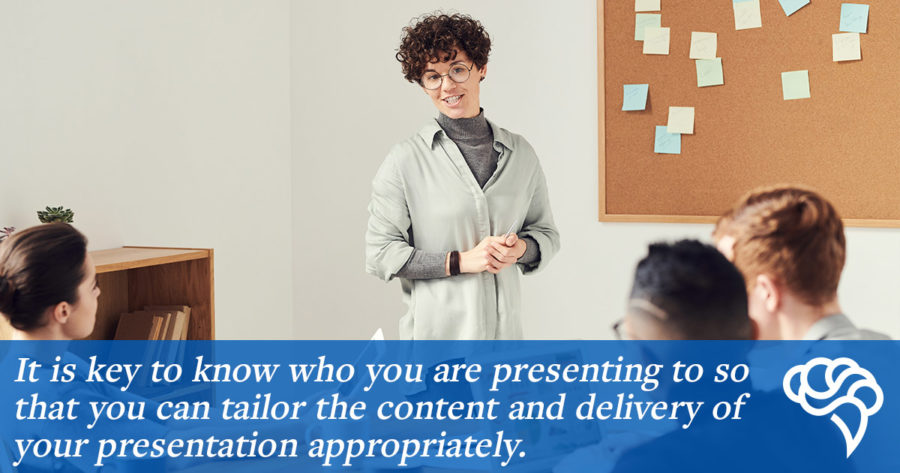If You Are A PhD, Then You Need This 21-Point Interview Presentation Checklist

I got my first industry job through networking.
I worked there for more than 1.5 years, but realized I wanted something more challenging.
So, I started applying for jobs but didn’t really get anywhere.
As advised by the Cheeky Scientist Association, I started networking and doing informational interviews while simultaneously applying for open positions.
Soon, I got a notification for a position that I had applied for and they offered me a phone interview.
Since no one in this company knew me, how I interviewed was extremely important.
It was really the first impression I would make on the people at this company.
To prepare for the interview, I knew I needed to highlight my transferable skills and demonstrate how my goals align with the company’s core values and mission.
I also knew I needed to practice, practice, practice!
This company’s interview process had 3 parts.
My first call was with a recruiter who asked me questions such as:
- Tell me about yourself.
- Why do you want to work for this company?
- Do you have experience in XYZ?
- Are you willing to relocate?
- Have you worked in a fast-paced environment?
- How do you like to communicate with colleagues?
At the end, the recruiter said that she would like to set up a Skype call between me and the hiring manager.
Yes! Part 1 complete!
My Skype call with the hiring manager was filled with both technical and behavioral questions, which I was ready to answer.
It went well and within 2 hours, they invited me to an on-site interview!
Part 2 complete!
To learn more about what the company was looking for in the onsite presentation, I reached out to the hiring manager to see if they had any insights to offer.
From this request, the hiring manager was kind enough to offer to have a call with me to discuss her expectations and what she wanted to see in my presentation.
Now that I knew exactly what they wanted, I started to prepare like crazy.
I would be giving a 50-minute presentation followed by 1:1 interviews with 11 people from cross-functional teams.
I worked really hard on the presentation to make sure I conveyed what they wanted to hear, that I highlighted my transferable skills, and that I made it clear why I am a good fit for the company.
The day of the interview, my presentation went really well!
All my preparations had paid off and I felt very positive after meeting the team.
Part 3 was complete, and now I just had to wait!
Within a week, I received an email from a recruiter asking for my references.
I had them ready.
And, about a week later, I got the job offer!
My extreme preparations for the onsite interview presentation were essential to my getting this job offer.
Why Only The Best Candidates Get An Onsite Interview

The competition to get hired in industry is fierce.
But, as a PhD, you are a top job candidate.
You just have to know how to set yourself apart and communicate your value, because getting to the interview stage is hard.
And, now is a great time to be on the hunt for a job.
According to a recent report by CNBC, for the first time in nearly 20 years, there are more job openings than people who are unemployed.
There are 6.7 million job opening and 6.4 million people looking for work.
Now, only a very small percentage of those 6.7 million will be competing directly against you, but that still leaves lots of competition.
Most companies receive hundreds of applications for a single position, while larger companies can receive thousands.
For example, Fast Company reported that in one year, Tesla received nearly 500,000 applications.
Submitting an application or getting a referral to hand your resume to the hiring manager is the very top of the hiring funnel and it narrows very quickly.
No matter how many job applications are submitted, a company will only call about a dozen applicants for the initial phone screen or video interview.
And, at the end of the funnel, there will only be 2-3 candidates given the opportunity for an onsite interview.
That means that if you get to this onsite interview stage, you will have already beat out hundreds or thousands of other applicants.
Companies are picky about who they bring out to a site interview because this is when hiring starts to get expensive.
On average, it costs a company about $4,000 to hire a new person, and much of that expense is incurred during the site visit, according to the Society for Human Resource Management.
A company is investing in you by bringing you out for a site visit, so the pressure is on.
You are so close to getting hired if you’ve been offered a site interview, so now is the time to dig in and give it everything you’ve got.
21-Point Checklist For PhDs To Give The Best Industry Interview Presentation
Before your presentation, call and find out what type of presentation the company wants you to give.
Ask what you should talk about and who will be there.
Don’t be scared to ask about the topic of the presentation or afraid you will look silly by asking.
The reality is that you will look ridiculous if you prepare a presentation of your research, but they wanted you to do a presentation about one of their products.
Always ask for clarification.
And, once you know what they want, it’s time to prepare.
Here is a 21-point checklist for PhDs preparing for an industry interview presentation…
1. Know your audience and tailor your talk to them.

Are you presenting to scientists, non-scientists, or a mixed audience?
Do they have a background in what you will be presenting?
Are they who you will work with, or are they supervisors?
It is key to know who you are presenting to so that you can tailor the content and delivery of your presentation appropriately.
2. Understand the purpose of your presentation.
What does the company want to learn about you from this presentation?
There are a few purposes for interview presentations.
1. Presenting your research
2. Pitching one of their products
3. Presenting about yourself
But, beyond these broad topics, it’s also important to figure out what they are looking for in the presentation in terms of skills that you have and to make sure you cover those items.
3. Know the one thing you want them to remember from your presentation.
Most people will only remember one thing from a presentation.
Just one.
So, think about what this should be.
Do you want them to remember a particular result you had in your research?
Do you want them to remember that you are really awesome at a particular skill?
Or, something else?
Once you figure this out, make sure that it is clearly communicated.
4. Talk, don’t read.
Do not read what is on your slide.
This is awful.
And boring.
And a waste of slide space.
Use your slides to show things that are hard to describe with words, such as data or images.
This will keep the audience’s attention much better than a wordy slide that you are reading to them.
They know how to read, you don’t have to do it for them.
5. Practice your presentation out loud.

Just saying your presentation to yourself in your head is not enough practice.
For an interview, you need to be at your very best.
Think about how much you prepared for your thesis defense presentation and apply that level of effort.
That is how you will impress your potential employer and get hired.
6. Set the context of your research.
In academia, we tend to become hyper-focused on our specific area of expertise.
When giving your interview presentation, you need to realize that your audience does not have the same background as you.
They need you to provide context for your research.
Ask yourself, “Why should these people care about my project?” and then use that to set the stage.
7. Don’t overwhelm the audience with too much data.
Yes, you have spent the last 5-7 years researching the same project and you have lots of data.
Do not show all this data in your interview.
Less is more.
Choose the most important, most impactful, and most relevant data, and show only that.
8. Monitor your breathing.
Are your breaths shallow?
Are you breathing quickly, or very rarely?
Practice taking slow and deep breaths as you give your presentation.
This will calm your nerves and make you appear more confident.
9. Don’t brag, but connect to the audience through failures and how you overcame them.
The main purpose of your interview is to persuade your potential employer that they should hire you.
You need to demonstrate that you are competent without sounding arrogant.
A great way to do this, is to talk about the minor failures within a project and how you overcame them to achieve the desired result.
This makes you seem both relatable and skillful.
10. Link your project to the company’s focus.
Always bring the focus back to the company you are interviewing with.
Do your research beforehand to figure out how you can connect your research to the company’s focus in a meaningful way.
This could be highlighting a product of theirs that was essential to your project, or demonstrating how the overall goals are similar.
You want to show that you are invested in the company and this is a great way to do that.
11. Have a slide that introduces you in a fun way.
Again, remember that the main point of this interview presentation is to convince your potential employer to hire you.
So, tell them a little bit about yourself with your presentation.
What do you like to do, besides work?
Adding in some fun details will make you more relatable and likeable, which will increase you chances of getting hired.
12. Vary the speed of your speech.
The main reason people sound monotonous is because they don’t change the speed of their speech.
Talking at the same pace for your whole presentation is boring.
Don’t talk too fast, but make sure there is variety.
Slowing down when making a key point is a good way to make sure you do this and to allow your listener to have time to grasp the concept you are making.
13. Spark interest through emotion and sensory details.
Let’s be honest, research can be dry.
Like… really dry.
So, spice up the story to keep your listeners’ attention by describing things with sensory details.
This will allow the audience to visualize what you are talking about.
Also, talk about the emotions involved in what you are presenting, as this will keep the audience invested in your story.
14. Use lots of white space on your slides.

Your slides need to be aesthetically pleasing.
This means simple and clean, with lots of white space.
A presentation that is packed with words and data is distracting for the audience.
A clean and focused slide allows you to maintain the audience’s focus on the important information and prevents them from looking at parts of the slide that you have not explained yet.
15. Check your spelling.
This always needs to be addressed.
Spelling and grammatical errors make you look sloppy — and no one wants to hire sloppy.
Use more than just the default spell check.
Read over your presentation a few days after you have created it, or have a friend look it over for mistakes.
16. Use only one font.
Use only one font and don’t use a weird font.
Stick to those tried and true fonts, such as Arial and Calibri.
Basically, you don’t want the audience to notice your font.
Keep it basic and keep their attention focused on the information.
17. Spend about 1 minute on each slide.
As a general guideline, when creating your presentation, know that you will spend about 1 minute on each slide.
So, if you are required to give a 15-minute presentation, you should have about 15 slides.
This guide will help you prepare and should help keep you on track for time when you are giving the presentation.
18. Use high quality images.
Pixelated or stretched images are distracting.
Only use high quality images of your data.
If you are using a picture to help make a point, again, make sure this is high quality, and also remember attribution.
Demonstrate your understanding of this by either using attribution-free images or by citing the source for your images.
19. Address the required technical skills for the position.
If you are not sure what parts of your research to present, choose data that was acquired using the technical skills the company is looking for in a job candidate.
Your interview presentation is a valuable opportunity to physically show your potential employer that you have the required skills.
You are not just telling them you have these skills, you are showing them data you produced using a specific technique.
Don’t ignore the importance of highlighting your relevant technical skills.
20. Include examples of you using transferable skills.
Just like you did with your technical skills, your interview presentation gives you the opportunity to show how you have used your important transferable skills.
Are they looking for a leader?
Then talk about a project where you led and managed others to achieve the result.
Are they looking for high-level problem-solving skills?
Then, discuss how you had to work through problems during your project.
Show them you have the right transferable skills and would make an awesome employee.
21. Tell an engaging story.
No matter what you are talking about, the bottom line is that you need to tell an engaging story.
If your audience is bored or disconnected from what you are saying, you can kiss the job goodbye.
Practice your presentation a lot so that, when delivering it, you can focus on being engaging and not on trying to remember what to say.
Just think about all the boring talks you have sat through and try not to do that.
If you have made it to the interview presentation stage, then you are one of the final few top candidates. So, this interview is the time to push further and prove that you are the best person for the job. This means extensively preparing for the interview presentation. Outlined here, are 21 things that you should prepare for leading up to your presentation, so that you can “wow” your potential employer and get hired. As always, after the presentation, follow up with thank-you notes and convey your excitement. An interview presentation is tough, stressful, and takes hard work — but, if you do it right, you will get hired.
If you’re ready to start your transition into industry, you can apply to book a free Transition Call with our founder Isaiah Hankel, PhD or one of our Transition Specialists. Apply to book a Transition Call here.

ABOUT AMRUTA AGHARKAR
Amruta Agharkar PhD, is an experienced scientist with 4+ years of industry experience specializing in pharmaceutical formulation, development, and analysis of dosage forms. She has over four years of experience as a product development and formulation scientist working in collaborative environments.
More Written by Amruta Agharkar































